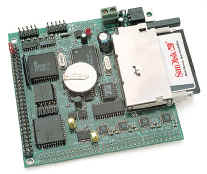
One of the competitors involved in this competition for the Army’s business, is Jim Hauser of AeroSpectra, Inc. In order to construct a data acquisition system that would meet the demands of the U.S. Army, Hauser came to TERN, Inc. in order to purchase the R-Engine-A (RA) microcontroller, a product that not only supports 40 analog inputs to test a variety of parameters, but also has the capacity to store mass amounts of data on a removable CompactFlash card.
The Army’s main criteria for a new data acquisition system are the capacity to be able to take in twenty minutes worth of data at 1,000 times per second. In order to accomplish this, they request that the controller have a minimum 16 channel analog to digital converter and are also concerned about storing a large amount of data that can be accessed extremely quickly and easily. The parameters of interest to the Army include: drop time, acceleration during the drop, the amount of stress placed on the parachute harness as well as other strains on the equipment, and the amount of shock load that occurs when the cargo or person touches down. All of this information must be recorded and stored on a single device. Working together, Jim Hauser and the engineers at TERN concluded that the RA would be able to meet the Army’s needs and more. It was determined that the RA would be an ideal controller for what the Army wanted to accomplish.
 The RA microcontroller works to collect, record, and store data in an efficient and convenient manner. By being programmed to record at a specific rate, with specific channels, for a specific length of time, it is able to acquire data from a set of given parameters. It is then placed in a load of cargo, in a test dummy, or with a real person which will drop from an aircraft by parachute. On the way down from the plane to the ground, the RA records analog data using 3 high-speed 12-bit parallel ADC chips for a total of 24 channels. This includes sample-and-hold, a precision internal reference, and an input range of 0-5 V. The data is then stored on the CompactFlash card. The card is taken out and linked to a PC when the user wishes to access their information in digital form.
The RA microcontroller works to collect, record, and store data in an efficient and convenient manner. By being programmed to record at a specific rate, with specific channels, for a specific length of time, it is able to acquire data from a set of given parameters. It is then placed in a load of cargo, in a test dummy, or with a real person which will drop from an aircraft by parachute. On the way down from the plane to the ground, the RA records analog data using 3 high-speed 12-bit parallel ADC chips for a total of 24 channels. This includes sample-and-hold, a precision internal reference, and an input range of 0-5 V. The data is then stored on the CompactFlash card. The card is taken out and linked to a PC when the user wishes to access their information in digital form.
With the use of this 50-pin CompactFlash interface, users of the RA can add an incredible amount of storage to their embedded application–up to 2GB worth! Once the CompactFlash card is taken out of the microcontroller and put into a PC, it takes less than a minute to download the data, working at a rate of 1 to 2 megabytes per second. When compared to downloading data using the Ethernet, this method is quite faster. Using the RA with removable CompactFlash cards to store data, instead of using the Ethernet to download the data acquired by the device, is a faster and therefore more convenient way to obtain the final readable data.
In addition to the afore mentioned capabilities, our RA microcontroller, equipped with the CompactFlash card, has the capability to easily change it’s program without one needing to go through the trouble of taking the board apart. Instead, because the board uses the CompactFlash interface, it is possible to copy the program from a PC directly onto the CompactFlash card. Then, whenever the Army wants to update its program code, all Jim Hauser would have to do is email them with the new specifications, and the new program can be implemented by simply writing this information to the CompactFlash card and inserting it back into the board.
“I don’t know how I could have done it otherwise. I am very pleased about the help and technical support I have received from the engineers at TERN. Working with them was one of the best things about the project.”
Jim Hauser
AeroSpectra, Inc
The simplicity and the ease of use that the RA allows, as well as the excellent technical support offered by TERN, has won Jim Hauser’s confidence in our products and business. When speaking about the role that TERN has played in the development of his project for the U.S. Army.
As of now, before their search for a faster, easier data acquisition system is complete, the Army cannot gain nearly as much information from their parachute drop missions as they would like to. Whether it be people or cargo using parachutes to descend from a plane to the ground, the technology the Army has employed to collect data on these parachute drops is not as capable as the technology currently available at TERN, Inc.
This is why Jim Hauser has decided to use our RA microcontroller to take, what he believes to be, an excellent shot at creating a superior product for the Army that will meet their needs and expectations perfectly. In the near future, the Army will test both competitors proposals and determine which they will decide to implement for missions and testing purposes. Until then, Jim Hauser can only wait, hopeful that his competition has not come up with a plan as outstanding as his own.


